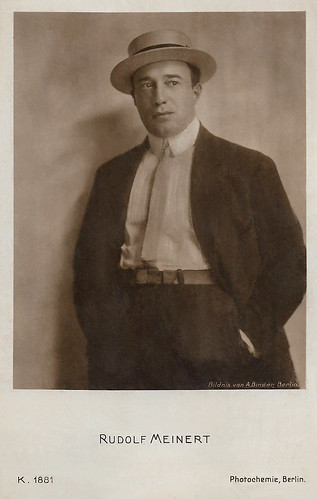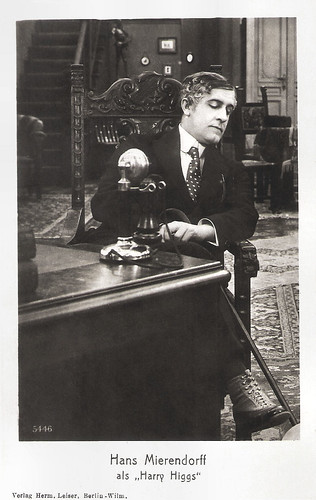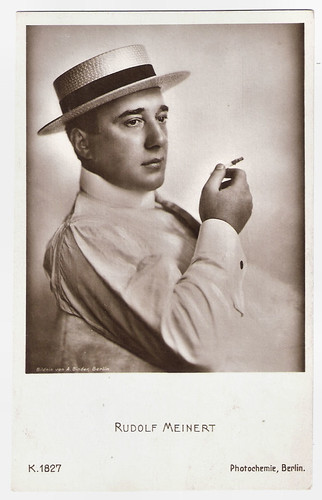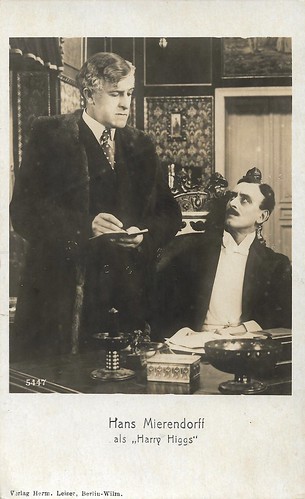
German postcard by Photochemie, Berlin, no. K. 1881. Photo: Alex Binder, Berlin.

German postcard by Verlag Hermann Leiser, Berlin-Wilm., no. 5446. Hans Mierendorff as Harry Higgs. In 1916-1920, Mierendorff incorporated the detective Harry Higgs in many films, produced and directed by Rudolf Meinert. The first one was probably John Rool (1916), and the last one Halloh! Hier Harry Higgs, wer dort? (1919). After that, Mierendorff did the last Harry Higgs film, Der Mann im Nebel (1919-1920), but directed by Mutz Greenbaum and produced by the Greenbaum company.

German postcard by Photochemie, Berlin, no. K. 1827. Photo: Alex Binder, Berlin.
Master Detective Harry Higgs
Rudolf Meinert was born Rudolf Bürstein in 1882, in Vienna. Meinert left secondary school prematurely and got a job at the Technisches Gewerbemuseum in Vienna. He then became an employee of the Swadlos-Söhne machine factory, and in 1901 he became an authorized signatory. In 1903 he completed his military training.
In 1904 he made his debut as an actor in Vienna and played in provincial theaters until 1907. In the 1907/1908 season, he appeared at the Deutsches Theater in New York. From 1908 to 1911 he was engaged at the Budweis City Theater, where he made his directorial debut in May 1909. Other stage positions as an actor and director were at the German Theater in Pilsen (1910/1911), the Jena City Theater (1911/1912) and again in Vienna (1912).
From 1913 he worked as a film director in Berlin and usually took over production with his company Prometheus-Film at the same time. Also in 1913, he married the screenwriter Erna Thurk. He had considerable success with his sensational detective films until he was drafted into the war in Galicia in August 1914. As a sergeant, he was seriously wounded in September 1915, which resulted in his dismissal as a war disabled in October 1915.
He then founded the Meinert-Film Gesellschaft in Berlin, which he expanded to include a subsidiary in Vienna at the beginning of 1916. From 1916 to 1919 he directed and produced 19 films about the master detective Harry Higgs with Hans Mierendorff as Higgs. From 1916 to 1920 he was a board member of the Berliner Film Club.
In May 1919 he was a co-founder of the first board of directors of the German Film Industry Employers' Association. In November 1919 Meinert-Film merged with Erich Pommer's Decla-Film-Gesellschaft Holz & Co. Meinert became production manager and in this function played a major role in the creation of the silent film classic Das Cabinet des Dr. Caligari/The Cabinet of Dr. Caligari (Robert Wiene, 1920).

German postcard by Verlag Hermann Leiser, Berlin, no. 5447. Hans Mierendorff as Harry Higgs.

German postcard by Photochemie, no. K.2604. Photo: Meinert Film. Ellen Richter in Die schöne Jolan (Rudolf Meinert, 1918), scripted by Willi Wolff. The man on her right is Hugo Flink, Richter's co-actor in this film.

German postcard by Ross Verlag, no. 643/10. Photo: Decla. Fern Andra and Hans Heinrich von Twardowski in Genuine (Robert Wiene, 1920). Rudolf Meinert co-produced this film, together with Erich Pommer.

German postcard. Photo: Ifa-Film. Ernst Rückert as Fritz von Wedel in the German silent film Die elf Schill'schen Offiziere (Rudolf Meinert, 1926), a period piece dealing with the failed uprising of Prussians officers against Napoleon in 1809.
Berlin, Prague, Vienna, Amsterdam, Vienna, France, Majdanek
After the merger of Decla with Bioscop AG in 1920, Rudolf Meinert took over a seat on the supervisory board of the new Uco-Film-Gesellschaft but left the group in 1921. On May 16, 1922, he founded a new Meinert Film Society. At the same time, he resumed his directorial work and started with a biography of Queen Marie Antoinette, Marie Antoinette - Das Leben einer Königin/Marie Antoinette - The life of a queen (Rudolf Meinert, 1922) starring silent diva Diana Karenne.
Meinert staged ambitious melodramas and dramas and shot Die Vorbestraften/Those with a criminal record (Rudolf Meinert, 1927) with Eugen Klöpfer, a socially committed film supported by the Berlin penal authorities. In 1927 he founded the German-Russian Film Alliance (Derussa), for which he made films with international casts.
After the Nazis came to power in 1933, Meinert, who was of Jewish origin, emigrated to Prague. In April 1934 he went to Vienna. That same year, he prepared in the Netherlands the tragi-comedy Het meisje met den blauwen hoed/The Girl With the Blue Hat (Rudolf Meinert, 1934) starring Truus van Aalten. Due to a royal decree to restrict foreign workers, which came into force in 1935, he returned to Vienna.
In Austria, he shot the comedy Alles für die Firma/Everything for the company (Rudolf Meinert, 1935) ;with Oskar Karlweis and Felix Bressart. It was his last film, of which also a Dutch version was made under the title De vier Mullers/The Four Mullers (Rudolf Meinert, 1935) starring Johan Kaart and Johannes Heesters. In May 1937 Meinert emigrated from Vienna to Paris. Various sources, including CineGraph - Lexikon zum Deutschsprachigen Film, stated for a long time that he moved to London in 1938 and probably died there in 1945.
Kay Weniger corrected this in his reference book 'Das große Personenlexikon des Films': "That Meinert went to Great Britain after the 'Anschluss' of Austria and allegedly died in London in 1945 or afterwards, as numerous sources claim, can be viewed as a 'canard'." In reality, at the outbreak of the Second World War, Meinert was interned in the Camp de Gurs camp in southern France and later taken to the Drancy assembly camp. From there he was deported on 6 March 1943, with Transport 51 from Drancy to the Majdanek concentration camp in Poland, where he was murdered.

German postcard by Ross Verlag, no. 151/4. Photo: Märkische Film G.m.b.H. Ernst Stahl Nachbauer, Erna Morena and Paul Günther in Die elf Schill'schen Offiziere/The Eleven Schillian Officers (Rudolf Meinert, 1932). Collection: Didier Hanson.

Dutch postcard, no. 1. Photo: Truus van Aalten and Roland Varno in Het Meisje met de Blauwe Hoed/The Girl With the Blue Hat (Rudolf Meinert, 1934).

Dutch postcard by M. B.& Z. (M. Bonnist & Zonen, Amsterdam). Photo: Filma. Roland Varno, Truus van Aalten, Dries Krijn and Lou Bandy in Het Meisje met de Blauwe Hoed/The Girl With the Blue Hat (Rudolf Meinert, 1934).

Dutch postcard by M.B. &. Z. Photo: Habé Film. Cissy van Bennekom and Johan Kaart in De Vier Mullers/The Four Mullers (Rudolf Meinert, 1935).

Dutch postcard by Habé Film. Sent by mail in 1935. Photo: Johannes Heesters in De Vier Mullers/The Four Mullers (Rudolf Meinert, 1935).
Sources: Wikipedia (German and English), Filmportal and IMDb.
No comments:
Post a Comment